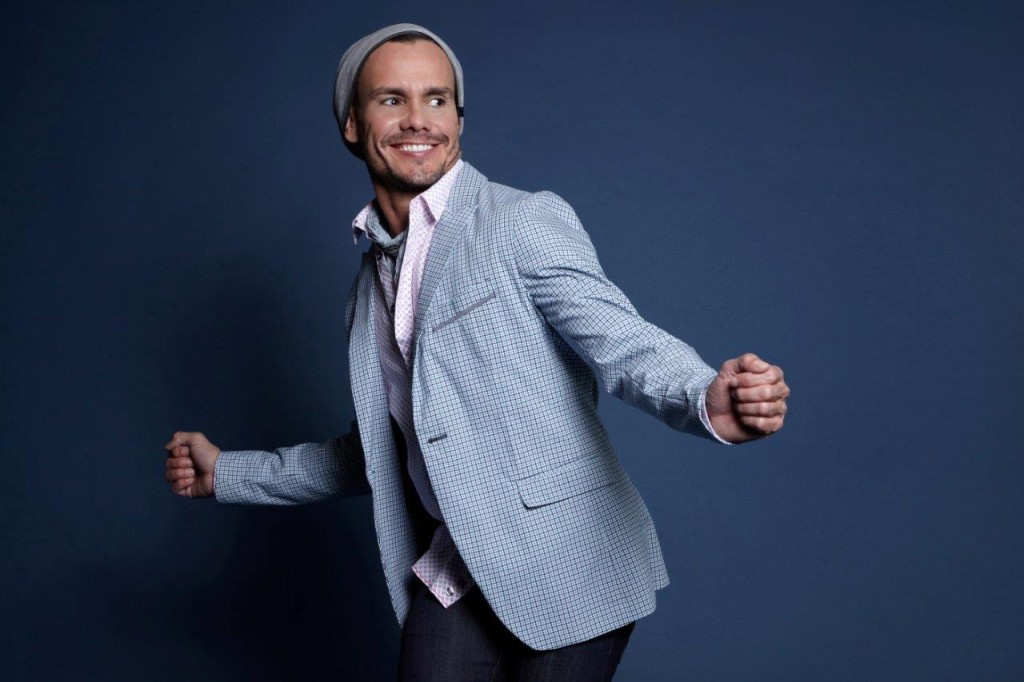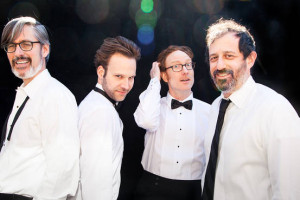
“The Kimmel Center is fifteen years old, now,” says Jay Wahl, artistic director, “and it is finding its place in the city.” One of those places is providing a place for emerging artists to create and perform new works in an intimate environment that nourishes talent. While the upstairs and affiliated venues at the Kimmel Center—The Perelman Theater, Verizon Hall, The Academy of Music, the Merriam Theater, and, sometimes, the Forrest Theater—are home to resident and touring companies and guest artists, the 150 seat black box SEI Innovation Studio in the basement provides an opportunity to nurture development of smaller works. “We want to enrich the culture here,” says Wahl of the programs they have developed to make use of the space.
One program is the SEI Theater Residency program that invites artists to spend two uninterrupted weeks developing and then performing new work. Two years ago the Residency Program collaborated with Dael Orlandersmith to work with solo performers, and out of that residency has grown two works—8 Stops by Deb Margolin and Hello! Sadness! by Mary Tuomanen—both of which premiered at the SEI Innovation Studio. This year’s residency is a collaboration with Shanta Thake, director of Joe’s Pub at the Public, a part of the Public Theater founded by Joe Papp in New York City, and the idea was to pair musical artists—singers, musicians, solo performers—with theatrical directors and see what happens.
It’s a unique opportunity for musicians “who don’t usually have access to funding sources,” says Thake, which leaves them out of the development process that has been the incubation for works that fit into a more definable genre. Musicals, for example, can be developed at the ASCAP Musical Theater Workshop. Fun Home, this year’s Tony Winner for Best Musical, which grew out of Allison Bechdel’s graphic memoir, was developed at the Ojai Playwrights Conference, the Sundance Theatre lab and The Public Theater’s Public Lab.
But what about the individual singer-songwriter, or even the cabaret singer who sings songs written by others? Where do they get to develop their vision? Playwrights know they need others to bring their work to life, and in the process they learn what works and what doesn’t. Singers work mainly on the music, not worrying about a strong narrative through line. That’s what makes this collaboration unique. It allows the artists to “merge the constructedness of playwriting and the circularity of song writing,” says Ethan Lipton, one of this year’s residents, about his own work.
And what are these artists creating? “Is it musical theater, a gig, a cabaret performance, a song cycle?” wonders singer-songwriter Jamie Leonhart. Are they writing songs for an album or working towards a stage performance? The idea, says Wahl, is for shows to grow out of these collaborations that will be developed over time and eventually be given a production. But in the meantime the artists were given the gift of two weeks of continuous creative time, and out of it grew a show chock full of new songs and new ideas.
This year, five teams of artists from music and theater worked together to create new works. Some pairings had already met before, others were working together for the first time. Most performers get together a few hours a week or a month, here they had nothing but the time to work, and work they did. The culmination was two public readings where the artists presented a portion of the work in its current state, and the audience had a chance to give feedback.
The two artists who performed at the Innovation Studio on Wednesday July 1, 2015, had already created alter-egos. Daniel Alexander Jones’ Jomama, is a black woman who left the United States after the Civil Rights period and has recently come back. She has to deal with how the world has changed while she was away, and she is not happy. Working with Bobby Halverson, with whom he has worked before, Jones says that when he writes he is creating songs “in service of Jomama.”
In the tradition of Pete Seeger and Phil Ochs who made political protest lyrical, Jomama tells us “You need to do better” as we tap our feet to her lecture on how we have messed up the world. Out of costume, Daniel’s performance, in blue suit and huge smile, hints at an elegant lady who will brook no nonsense. Halvorson’s Galveston B.B. Stone Model guitar holds its own place on stage, as Jomama sadly reminds us that a “Supernova means a star is dying.”
Local actor and performer Dito Van Reigersberg, co-founder of Philadelphia-based Pig Iron Theater Company, whose alter ego Martha Graham Cracker is well-known to Philly audiences, and working for the first time working with Dave Sweeny (Johnny Showcase) and Eliza Hardy Jones and Vince Federici, left himself open to explore songs beyond Martha’s repertoire.
“I thought of Martha as a release valve,” he says about the character he has channeled for ten years, “now I’m wondering if there isn’t something more.” A few songs, filled with wit and innuendo, are clearly Martha—“Drag Queen with a Large Vocabulary” and “Can I Sit on It?”, but a Joanna Newsom-inspired song—“The Diving Bell and the Butterfly” and “I’m Not Trying to Stop the Rain” allowed “a different person to come through,” Van Reigersberg said, and he got to sing in a deeper range.
This is a group that hasn’t worked together before and they’re not sure where they will go from here. Each has a local career, and the time they’ve been able to spend together is a precious commodity in their busy schedules.
The artists on Thursday July 2, 2015, came from diverse backgrounds as well.

Ethan Lipton, a playwright and musician whose last work No Place to Go, about a man who is outsourced to Mars, premiered at the Public Theater as part of their Emerging Writers Group. Although he didn’t plan to work on another space odyssey, his current work turns out to be a space story as well. In songs with a country twang and a narrative style reminiscent of Garrison Keillor, Lipton tells us the tale of a man who buys a spaceship jalopy and finds himself at the Caloris Impact Basin on Mercury struggling with “space sadness”—“a combination of despair, mono, and a shitty attitude.” Songs like “Have You Ever Had A Dream” and the playful “That’s Yoga,” which lists all the things we do that are and aren’t Yoga, keep the story moving.
Lipton usually works with a band, but they were only available for a week so he spent the second week on his own and still managed to churn out an impressive amount of work. Lipton comments on his love for what he calls “the slight absurdity in the mundane,” and says that he ultimately wants to create an “imagined experience for the audience, not just an empathic one.”
Singer-songwriter Jamie Leonhart was paired with Joana Settle who moved from Brooklyn to Philadelphia to become director of the University of the Arts’ Ira Brind School of Theatre. Since coming to Philly she has directed Rapture, Blister, Burn at the Wilma Theater and more recently Hands Up: 6 Playwrights, 6 Testaments at the Flashpoint Theatre Company while she also works on directing Stew and Heidi Rodewald’s new musical, The Total Bent, which will be produced at the Public Theater in the fall.
Leonhart, who describes her music as “Intellectual Pop,” writes about the challenges of being a mother and an artist, two roles that demand her full attention, which means she is always feeling dissatisfied. Accompanied by her husband and two UArts student, Leonhart sings about the challenges of being a mother and an artist. She wants to “explore the hard parts of parenting, the things moms lie about.”
Once her son was born, she said, if she was going to spend time away from him, she wanted it to be worth it. The songs are lyrical, and, Sondheim-like, they’re a running discussion, all verse, no chorus, a story of competing with other mothers to get her son into the right classes, an anecdote about giving a talk at TED and “flailing,” in her own mind failing.
“The time to leave is when you’re adored,” she sings, before the child and responsibilities mean your time and attention will always be split. ”How am I going to get anything done,” is the mantra of the mother-artist with which she struggles.
“It’s not candy-coated,” says Settle, about the material. She’s impressed by “the essential selfishness of piece. It’s not about her husband, not about marriage, it’s about herself.”
Although it’s an arranged marriage, they see themselves as kindred spirits. Leonhart says she’s the controlling one, while Settle is the free spirit, and yet they appreciate each other. The material is part of what they see as a longer 80 minute set, although they’re not quite sure what form it will take.
Migguel Anggelo, a Venezuelan-born artist who has lived in Miami and more recently New York combines the stories of his life as an immigrant with a large dose of Latin charm. “Working with Migguel is like working with a jar of glitter,” says Wahl, about the performer who seems to have a perpetual smile on his face. Paired with theater director David Drake, who focuses on biographical theater, and his musical director Mau Quiras, Anggelo is creating 12 songs for a CD called English with an Accent. Perhaps to be changed into a show similar to his most recent work, I Inmigrante which he performed at Joe’s Pub.
Anggelo’s style is unexpected. As a child, he fell in love with the SOUND OF MUSIC and wanted to sing like Julie Andrews. He studied classical music in Germany and performed in musical theater. At one point, he says, he went to see a vocal coach to get rid of his accent. She told him not to, it would change who he is. The resulting show is the story of a young man confronting the challenges of an immigrant exploring his new home while at the same time honoring his heritage.
Wahl and Thake acknowledge that it’s hard to find support for transformative works such as these and are delighted to be able to support these artists on their journey. They look forward to seeing which of these projects turn into works they can produce over the next year or so.
KIMMEL CENTER 2015 RESIDENCY PROGRAM, FREE PUBLLIC READINGS July 1-2, 2015, at the SEI Innovation Studio, Kimmel Center for the Performing Arts [300 S Broad Street]; kimmelcenter.org

Glad to see the contributions of Phil Ochs acknowledged.